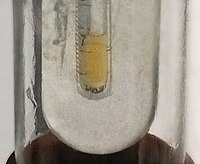
Photo from wikipedia
Granular activated carbon (GAC) adsorption is well-established for controlling regulated disinfection byproducts (DBPs), but its effectiveness for unregulated DBPs and DBP-associated toxicity is unclear. In this study, GAC treatment was… Click to show full abstract
Granular activated carbon (GAC) adsorption is well-established for controlling regulated disinfection byproducts (DBPs), but its effectiveness for unregulated DBPs and DBP-associated toxicity is unclear. In this study, GAC treatment was evaluated at three full-scale chlorination drinking water treatment plants over different GAC service lives for controlling 61 unregulated DBPs, 9 regulated DBPs, and speciated total organic halogen (total organic chlorine, bromine, and iodine). The plants represented a range of impacts, including algal, agricultural, and industrial wastewater. This study represents the most extensive full-scale study of its kind and seeks to address the question of whether GAC can make drinking water safer from a DBP perspective. Overall, GAC was effective for removing DBP precursors and reducing DBP formation and total organic halogen, even after >22 000 bed volumes of treated water. GAC also effectively removed preformed DBPs at plants using prechlorination, including highly toxic iodoacetic acids and haloacetonitriles. However, 7 DBPs (mostly brominated and nitrogenous) increased in formation after GAC treatment. In one plant, an increase in tribromonitromethane had significant impacts on calculated cytotoxicity, which only had 7-17% reduction following GAC. While these DBPs are highly toxic, the total calculated cytotoxicity and genotoxicity for the GAC treated waters for the other two plants was reduced 32-83% (across young-middle-old GAC). Overall, calculated toxicity was reduced post-GAC, with preoxidation allowing further reductions.
Journal Title: Environmental science & technology
Year Published: 2019
Link to full text (if available)
Share on Social Media: Sign Up to like & get
recommendations!